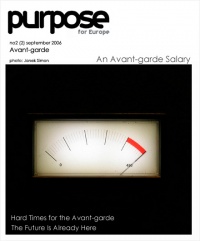
On the margin
Avant-garde
Where does the name Gallery Avant-garde come from? What is your programme?
The name of the gallery is historic, which means that it was founded much earlier than any of its present staff can remember. I hope that it’s not about the trend so described by historians of art, the trend that covered the period from more or less 1918 to 1945, but about showing things that are new, controversial sometimes, perhaps opening some other door in the world of Polish and world art.
At the moment the gallery is being renovated. What is going to change?
The renovation, unlike conversion, is being made to preserve the present state of the building, and I hope it will improve it a little. The hall will be painted more tolerable colour. We have replaced pistachio-green with the currently more fashionable sand-like. The display cabinets? have been changed, which should prevent works fading in two weeks’ time, and the temperature inside will be more or less fixed. Before, it fluctuated from -20 in winter to +45 in summer. As for the programme, I hope we will maintain the current line - we will show as many great and as few poor and uninteresting exhibitions as possible. Of course, the problem is that very often the opinion can be formed only after the exhibition has been shown to the audience.

For many years you have been the co-organizers of the National Exhibition of Young Painting and of the Geppert Contest. Tell me about this contest, who and how can participate?
This contest is the only such event in Poland. Whether you enter it is not your own initiative. Each year the organizers invite a different but similar number of around eight national curators, and independently of them – jurors. The curators, basing on their knowledge of the current situation in Polish young painting, invite participants. In that way the exhibition and the contest offer a unique opportunity to see, in one place and time, the cross-section of what is important and topical in young painting - and with the eyes of specialists. I hope that owing to the exhibition some trends and tendencies for the two following years are defined. At least such is my ambition.

What is our avant-garde like today? Can we speak about avant-garde artists?
It’s difficult to answer this question unambiguously. However, when you observe the environment, you can see people whose appearance doesn’t differ much from the appearance of young urban professionals (yuppies). Entering slowly but unavoidably the international art market our reality, the romantic vision of the avant-garde who, sloppily dressed, held night-long discussions about art - is vanishing. In our country young artists simply want to sell their works and to get by, and I would be the last to condemn them for that. It seems to me that in Poland nowadays it is difficult to be a controversial artist who raises difficult issues and creates risky forms. If you compare that to the situation in the neighbouring countries, e.g. to Czech, there is no place for avant-garde artists in Poland.

Is it possible to combine art with enterprise?
Yes, it is. Here are some examples: Jeff Koons, Mark Kostabi, and some others. In Poland nobody has been successful so far, were we to approach the issue seriously and honestly.
Thank you for conversation.
Check the archive

nr 25 October 2006
theme of the issue:
AVANT-GARDE
< spis treści
Article
From the Editors
Presentation
Janek Simon
Analysis
Avant-garde hard time - Artur Zaguła
Career in Culture
Souls agreement - interview with Agula i Tom Swoboda
Culture Industries
Avant-garde salary - Artur Zaguła
Workshop
To create and live - Maciej Mazerant
Young Culture
Something new - conversation with Jankiem Simonem
On the margin
Avant-garde - conversation with custodian Paweł Jarocki





